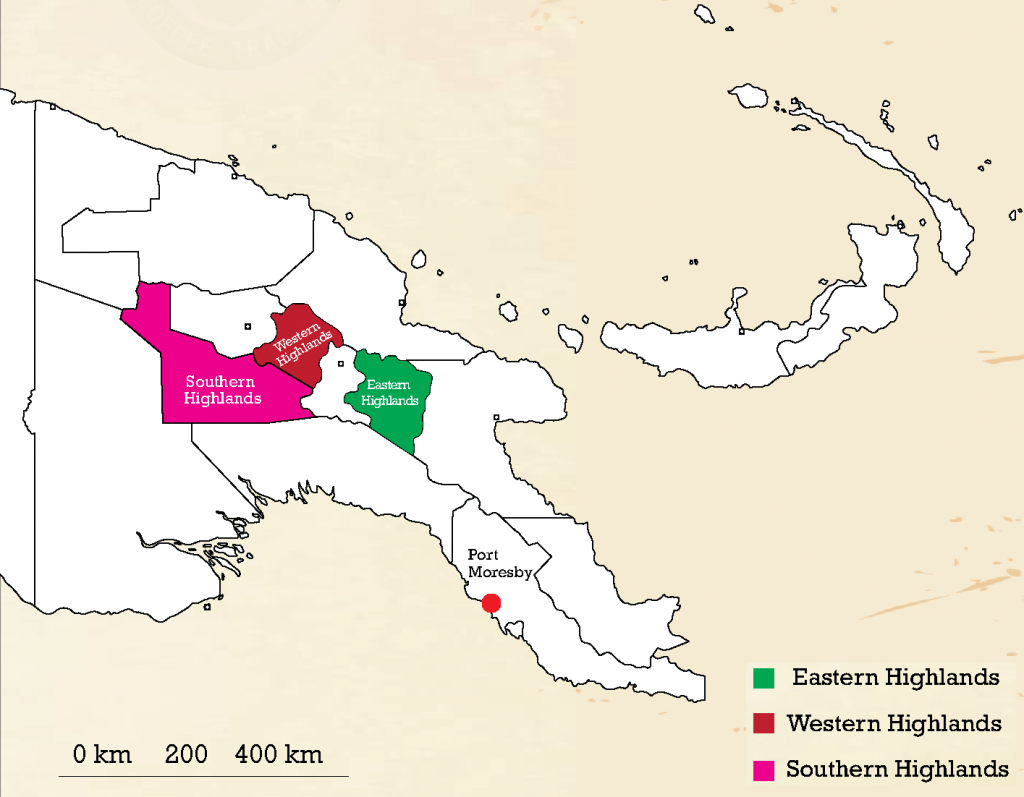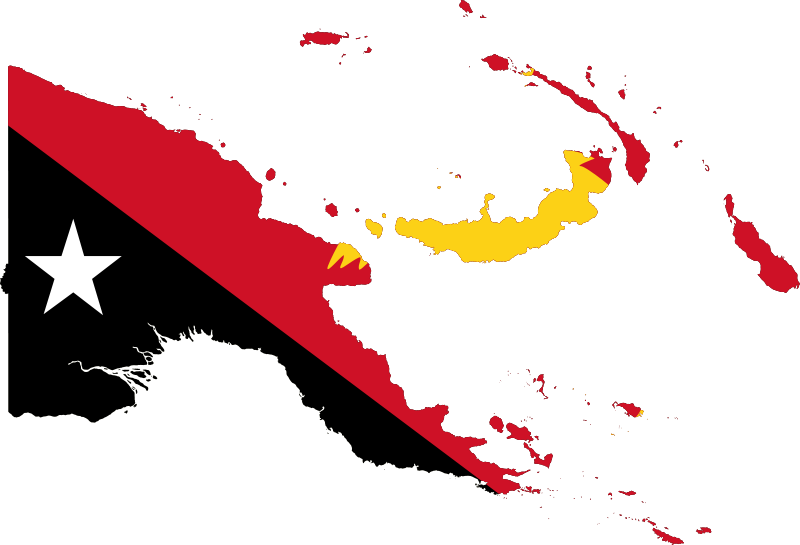Papua New Guinea Kimel Estate X
About Papua New Guinea and its Coffee Production
Coffee production in Papua New Guinea is the country’s second-largest agricultural export, after oil palm. It accounts for approximately 1% of world production, according to the United Nations Conference on Trade and Development (UNCTAD). The crop remains the main source of income for many highland farmers. The country currently exports around 1 million bags of coffee, bringing 340 million kina to the economy.
Coffee is the highest foreign exchange earner for Papua New Guinea, the majority of which is grown in the Eastern Highland Province, the Western Highland Province, and Simbu. With the industry not derived from a colonial plantation-based system, production is largely by small farmers with landholdings that grow as little as 20 trees per plot in “coffee gardens” alongside subsistence crops. Predominantly in isolated places, the product is mostly certified as “organic coffee”
In Papua New Guinea there are approximately 2.5 million people employed in the industry (or nearly half of the total population), with 280,000 smallholder coffee growers, 660 larger farmers cultivating areas of 1–30 hectares (2.5–74.1 acres), 65 large plantations, 18 registered exporters, 51 registered processors and over 6,000 roadside buyers. However, although 12 provinces are active in the coffee industry, the bulk of coffee (approximately 90%) is produced in the five Highlands provinces, Western Highlands (45%), Eastern Highlands (37%), Simbu (6%), Morobe (5%) and East Sepik (5%).
Washed mild arabica highland coffee dominates the industry in Papua New Guinea (PNG), accounting for 95% of production, the other 5% being lowland washed robusta. The robusta coffee is of poorer quality, being darker, more bitter, with less flavour than the Arabic variety is generally used for cheaper instant coffee.
Where does the Papua New Guinea Kimel Estate X come from?
The Kimel plantation was first established in 1974 by an Australian named Bobby Gibbs; it is now fully owned by traditional landowners the Opais, being the main tribe in this area. The estate is located in the Western Highlands in the Wahgi Valley, a very fertile region surrounding Mount Hagen, near a small town called Banz.
The Western Highlands area is the largest coffee-producing province in Papua New Guinea (PNG), with the Wahgi Valley and the Dei Council, in particular, which the estate borders, producing some of the finest coffees in PNG.
The elevation of the estate is 5,200ft above sea level and the soil is mostly rich sandy loam. The temperature ranges from 6°C to 29°C and the annual rainfall is approximately 260 to 270 mm
The estate also provides schooling for children and medical facilities for the workforce and their dependents. Clean running water has been made available to the estate workers by way of a community project and its implementation is overseen by the estate’s management. Since the estate is located along the Kimel river, from which it derived its name, it has access to good clean water for the processing of its crop. The estate’s management also implements some ecology-friendly policies with regard to environmental issues, such as the recycling of pulp and water used during wet processing.
The Kimel Estate operates its own wet and dry mill, covers 600 hectares and accepts the production of local and village plantations which covers an additional 1000 hectares. Growing Arusha, Bourbon, Typica varietals, the original trees on the estate were from the Jamaican Blue Mountains. A combination of the unique environment and plantation practices such as using coffee pulp for fertilizer, dried husks for heating and fresh, unpolluted water from the mountains all add to the estate’s sustainability practices. Kimel beans are acknowledged for their distinctive characteristics, especially the savoury notes and bright, delightful acidity.


Arabica vs Robusta
Coffea Arabica
Coffea Arabica, also known as the Arabian Coffee, “coffee shrub of Arabia”, is a species of Coffea plants that are a member of the genus of flowering plants in the family known as Rubiaceae, most commonly called Arabica around the world.
Arabica beans are often considered superior in taste, despite containing less caffeine than Robusta. Arabica tends to have a smoother, sweeter taste, with flavour notes of chocolate and sugar. They often also have hints of fruits or berries. Robusta, on the other hand, has a stronger, harsher and more bitter taste, with grainy or rubbery overtones.
According to the International Coffee Organisation, more than 60 per cent of world coffee production comes from Arabica cultivators. This was the type of bean that started off the whole coffee story in Ethiopia, and it still grows best in higher elevations. Glorious in smell, Arabica flowers appear only after a couple of years and produce ellipsoidal fruits, inside which are two flat seeds known as coffee beans.
An Arabica shrub grows up to 15 feet (5m) tall but is usually pruned to about 6 feet (2m) to make it more commercially viable. Arabica has two sets of chromosomes, so it is capable of self-pollination. This means that it remains generally stable as a species because cross-pollination is less probable.
Arabica Varieties
Of the two most common varieties of Arabica coffee beans, Typica was the first variety to be discovered. It is therefore regarded as the original coffee of the New World. It is also a low-yielding variety that is valued for its excellent cup quality.
Bourbon varieties of Arabica, on the other hand, are often prized for their complex, balanced aromas and have spawned many high-quality mutations and subtypes. A few natural mutations of Arabica are known as Caturra, San Ramon, and Pacas. There are also a number of Bourbon cultivars that have been propagated to suit the regional climate, environment, and elevation.
Coffea Canephora (Robusta)
Coffea Canephora or Coffea Robusta is a species of Coffea plants that are a member of the genus of flowering plants in the family known as Rubiaceae, Though widely known as Coffea robusta, the plant is scientifically identified as Coffea canephora, which has two main varieties, robusta and nganda. Robusta has its origins in central and western sub-Saharan Africa.
Despite its flavour being considered less refined, Robusta is widely used in espresso blends because it is known to produce a better crema (the creamy layer found on top of an espresso shot) than Arabica. It is hardier, more resistant to disease and produces better yields. It also packs more caffeine!
It is thought that the amplified caffeine content of Robusta, along with its chlorogenic acids (naturally occurring antioxidants) is a result of the plant’s self-protection mechanism in warding off pests and disease. When present at low levels, chlorogenic acids are considered an important part of a coffee’s flavour profile. However, Robusta contains higher levels of these acids and the oxidation products generated by these can sometimes introduce unwanted flavours, potentially compromising cup quality.
There are a number of subtypes of the Robusta bean, each exhibiting a unique set of characteristics. The same is true of Arabica beans. Robusta varieties sometimes exhibit greater immunity to disease and increased production capacity in comparison to Arabica. Growing well at lower altitudes, Robusta thrives in areas where Arabica would be devastated by fungus and other diseases and pests.
Robusta is a stouter plant, about twice the size of Arabica and it grows well at higher humidity. After flowering, the berries take almost a year to ripen. Robusta is self-sterile, therefore, cross-pollination by wind, bees and other insects are necessary for the plant to reproduce.
Tasting Notes for Papua New Guinea Kimel Estate X
| Country | Papua New Guinea (PNG) |
| Screen Size / Grade | Screen 15/16, Grade X |
| Bean Appearance (green) | Mixed visual commercial finish |
| Acidity | High |
| Body | Medium |
| Bag Size | 60kg |
| Harvest Period | April to September |
| Description | A good commercial-grade bean, excellent for blend production. This bean can be successfully used in espresso blends and equally in domestic blends for French press and syphon infusion. Kimel – x offers good complexity and compliments a blend when paired with a combination of other origins for a larger outcome. |
| Tasting Notes | Flavours of mixed citrus and malt with fine, high acidity. |
| Strength | |
| Processing Method | Washed |
| Altitude | 1584 MASL |
History of Coffee in Papua New Guinea
Coffee production in PNG dates back to 1926/1927 when the first Jamaican Blue Mountain Coffee seeds were planted. The Coffee Research Institute claims that coffee was introduced to British Papua in 1890, although it is widely accepted that commercial production only took off in the country in the late 1920s. In Sangara, Papua New Guinea in the foothills in the southeast of the country, 18 commercial coffee plantations were established in 1926, paving the way for commercial production from 1928.
In the 1960s, the infrastructure developed significantly in Papua New Guinea which facilitated a marked growth in the industry, easing the transportation of coffee beans from plantations to the mills to be processed and exported. The coffee industry in Papua New Guinea thrived in the 1970s, benefiting from a slump in production in Brazil on the international market because of problems with frosts. In the 1980s, coffee plantation production declined in Papua New Guinea and decentralized towards localised small coffee farmers who are now accountable for over 85% of total national production. The coffee boom in the 1980s profoundly affected many coffee plantation owners who incurred debts they could not pay off, with the result that many were made redundant. From 1986, a number of cases of coffee rust, caused by Hemileia vastatrix, also affected some parts of Papua New Guinea which had previously been free of the disease.
The coffee industry in Papua New Guinea reached a peak in 1998 when it accounted for about 38% of PNG’s non-mineral exports and 13% of total exports. Between 1995 and 1998, coffee production contributed to 42% of the revenue of PNG’s total agricultural exports. Since then the industry has rapidly declined, affected by a world depression in coffee prices with prices falling up to 60%. As a result, production slumped by 23% in 2000 and remained stagnant in 2001.
A contemporary problem facing the industry is poor infrastructure and frequent hijacking by bandits which is a major issue in Papua New Guinea, with some of the larger coffee producers losing some 50% of their total produce through theft annually. This is an issue of law and order that is creating a loss of revenue to the producers through unchecked theft, which is attributed to the inadequate opportunities for the youth of the country to get suitable avenues for education and, more importantly, getting jobs after schooling.
Increased annual production by other competing countries in the world market is also affecting the contemporary industry in Papua New Guinea. In 2009, coffee was reported to be responsible for 18.5% of PNG’s agricultural exports and 4.7% of total export revenue, a dramatic fall since the 1990s. In recent years, coordination between the private and public sectors has increased as has a movement towards greater sustainability, with improved soil nutrition management and retention and education of farmers in prolonging the agricultural productivity of their land.
Interested in some PNG?
Visit our PNG page or Espresso Bar to buy a bag of our Papua New Guinea Kimel Estate X.
